Bald Uakari Profile
The bald uakari or bald-headed uakari (pronounced ‘wakari’) is one of four species of uakari, a small new world monkey, found only in the western Amazon in várzea forests of Brazil and Peru.
Perhaps the most striking of the four species, the bald uakari is instantly recognised by a long ginger shaggy coat, and a hairless head and face – which is coloured bright red.
Both male and female bald uakaris exhibit the bright crimson face and head colour that helps define this species. These social primates live in large groups, sometimes up to 200 individuals, though ‘troops’ of around 30 are more common.
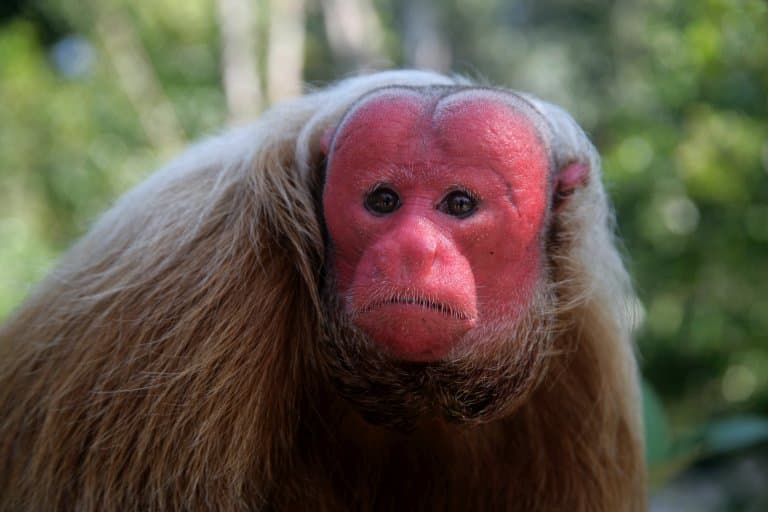
Bald Uakari Facts Overview
| Habitat: | Tropical forests and rainforests. Usually near water sources |
| Location: | Amazon rainforests of Brazil and Peru |
| Lifespan: | 18 years in the wild, 30 years in captivity |
| Size: | Body around 50cm in length and tail around 15cm in length |
| Weight: | 3kg |
| Color: | Fur colour ranges from cream to dark red. Face and head is bald and bright red |
| Diet: | Fruit, seeds, nectar and insects |
| Predators: | Large birds of prey and snakes |
| Top Speed: | Not known, but moves quickly through trees |
| No. of Species: |
1 |
| Conservation Status: |
Vulnerable |
Uakaris are relatively quick moving monkeys, equally at home in the trees or on the ground. They prefer to live in thick rainforests, which often flood in the rainy season. During this time, they spend the day leaping and climbing through the trees in search of seeds, fruit and the occasional caterpillar.
When their forest is not flooded, the bald uakari move quickly across the forest floor on all fours, searching for fallen seeds and fruit. They have also been known to walk and jump on two legs.
Bald uakaris spend much of their day searching for food. They require large amounts of fruit, seeds, flowers and nectar to survive and thus they are very specific in their habitat choice. Living in the rainforest on the edge of rivers ensures that there is a plentiful supply of their favourite foods. They use colour vision and smell to find the correct fruits and seeds and will often sit down on branches to enjoy their meal. When not looking for food, the bald uakari can often be seen lying belly-down on a comfortable branch.
The bald uakari has few natural predators, but large eagles and snakes are capable of killing smaller individuals. Ocelots and other carnivorous mammals may prey on young uakaris but large group sizes usually deter these predators. Uakaris are often found feeding amongst other primate species, such as spider monkeys and this also provides extra protection from potential predators. The bald uakari does not travel during the night, preferring to move high up the canopy to a safe sleeping site.
Uakaris are intelligent and peaceful primates, which helps with understanding troop dynamics when living is relatively large assemblies. Bald uakari groups are fluid in nature and individuals may leave the group and rejoin at different times. There seems to be little dominance shown in the groups, however elder members will often determine feeding times and sites and lead the smaller foraging groups to these. In this type of group structure, it is especially important for uakaris to understand and interpret other individuals’ behaviour to ensure the group remains harmonious.
Due to their very specific habitat preference of várzea forests which that flood seasonally, bald uakaris are found in a relatively small area along the river boundary between Brazil and Peru between the Yavarí and Ucayali rivers.
They are highly susceptible to habitat change and disturbance and prefer areas far from human habitation. As well as this, female uakaris only give birth to a single young every 2 or more years.
All these factors have resulted in the bald uakari being designated as vulnerable to extinction but conservation groups are working diligently to protect their habitats from deforestation and hunting.
Interesting Bald Uakari Facts
1. Their head and face color helps communicate health
Its crimson red face is due to the lack of skin pigments and a higher concentration of capillaries that run under its facial tissue.
It is suggested that the intensity of redness is determined by the overall health of an individual, therefore only healthy and strong uakaris will have bright red colouration. Pale faces might be a sign of illness, such as malaria which is rampant in their habitat. 1
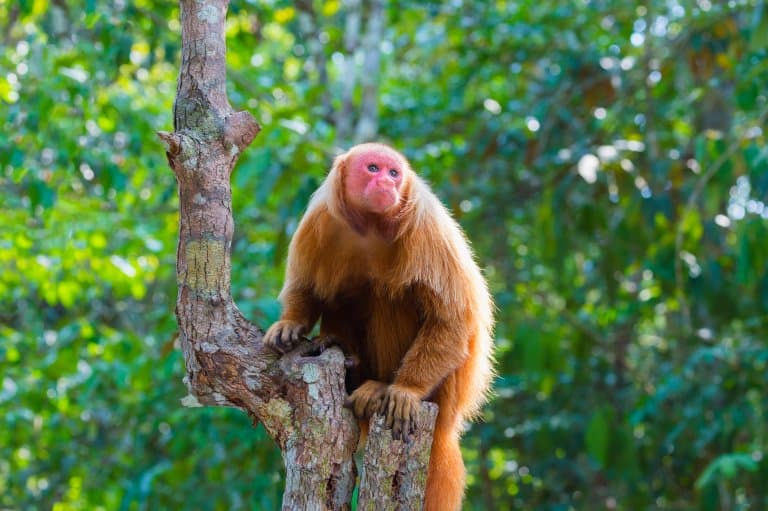
2. Redness plays a role in mating selection
Facial redness plays a role in sexual selection, as the redness of a female’s face correlates with her estrogen levels and a male’s correlates with his testosterone levels.
This helps uakaris chose a suitable mate, ensuring a higher chance of a succesful mate and that their offspring will also be healthy individuals.
3. Their tails are the shortest of all monkeys found in the Americas
Unlike most other monkey species in their range, the bald uakari does not use its tail to help it move through the forest.
In fact their tails are very short, usually only around 15cm, and they cannot use it to grip tree branches as they move, which is impractical for forest life.
Instead uakaris rely on their strong, long arms and legs to propel them through the canopy at surprisingly fast speeds.

4. Bald uakaris wave their tails when excited
Similar to dogs, some uakaris move their short tails to express pleasure, or when they are anxious!
5. They are able swimmers
Living in flooded forests, it is no surprise that uakaris can swim relatively well.
6. Subspecies have different colored coats
There are 4 subspecies of bald uakari, which include:
- White bald-headed uakari (Cacajao calvus calvus)
- Ucayali bald-headed uakari (Cacajao calvus ucayalii)
- Red bald-headed uakari (Cacajao calvus rubicundus)
- Novae’s bald-headed uakari (Cacajao calvus novaesi)
Each of these subspecies are recognisable by a slightly different colored long coat, ranging from blonde, red, gold to orange.
Thick fur helps protect uakaris from biting insects and keeps them drier in heavy rainfall.
2
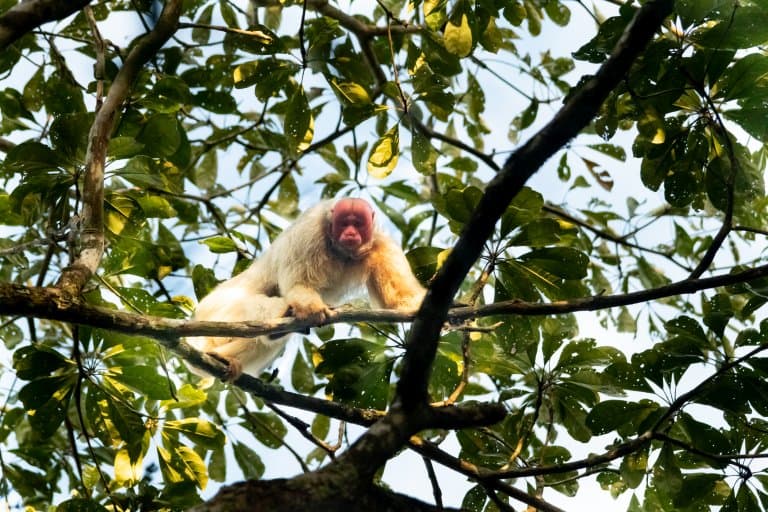
7. Bald uakaris display pleasure or anger on their faces
They can make at least 10 different types of facial expressions which communicate different emotions, and are further highlighted by their red faces.
8. They enjoy eating fruit from wild palms
Bald uakaris find the sweet fruits of the Moriche palm irresistible.
9. Uakaris have strong jaws and well developed teeth
Cracking into hard nut and seed shells requires a big, sharp set of teeth. 3
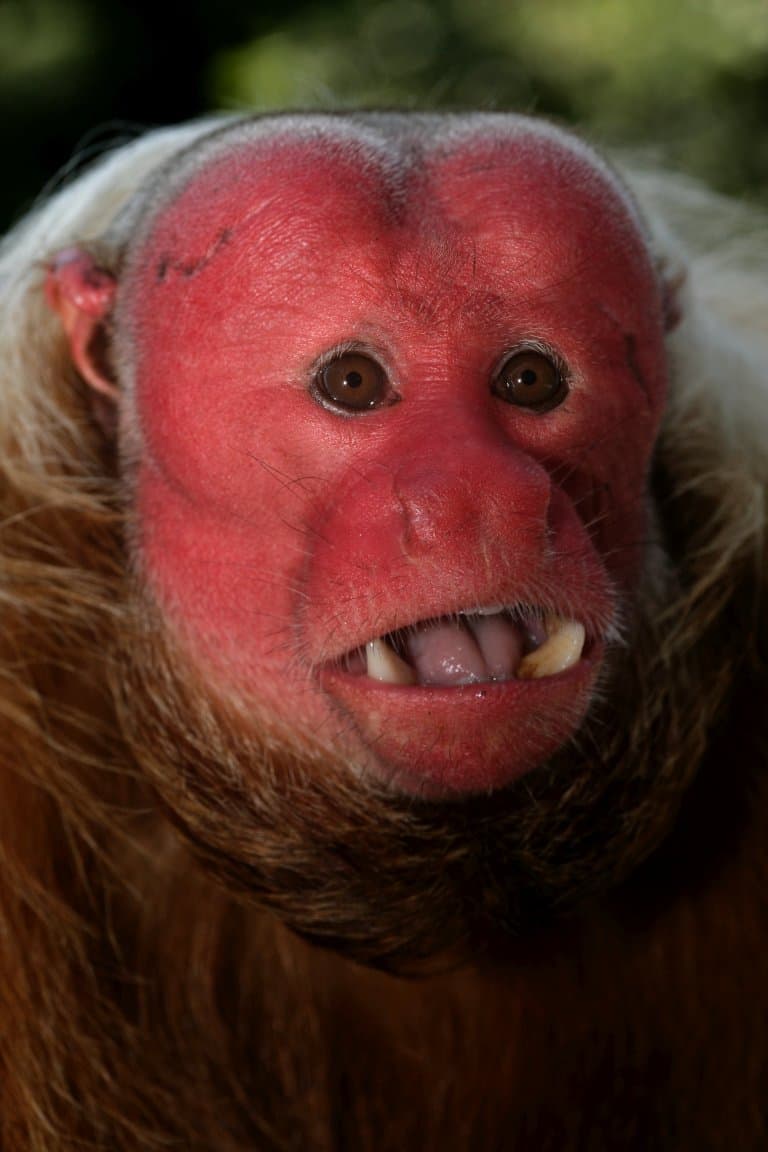
10. Baby uakaris are very dependent on their mothers
For the first 5 months of their lives, young uakaris do not leave their mothers’ side – clinging to them 24/7. Young uakaris are extremely playful and be quite a handful for their mother.
11. They travel 5km (3 miles) to find the best food sites
Bald uakaris can travel 5km (3 miles) in a day to locate fruiting trees, which is quite a long distance for a small primate!
12. Bald Uakaris are quadrupdal, and bipedal
Bald uakaris use all four limbs when walking and running on the ground and when traveling through the trees.
However, on the forest floor, they can also walk and jump using just two legs like a human (bipedal)
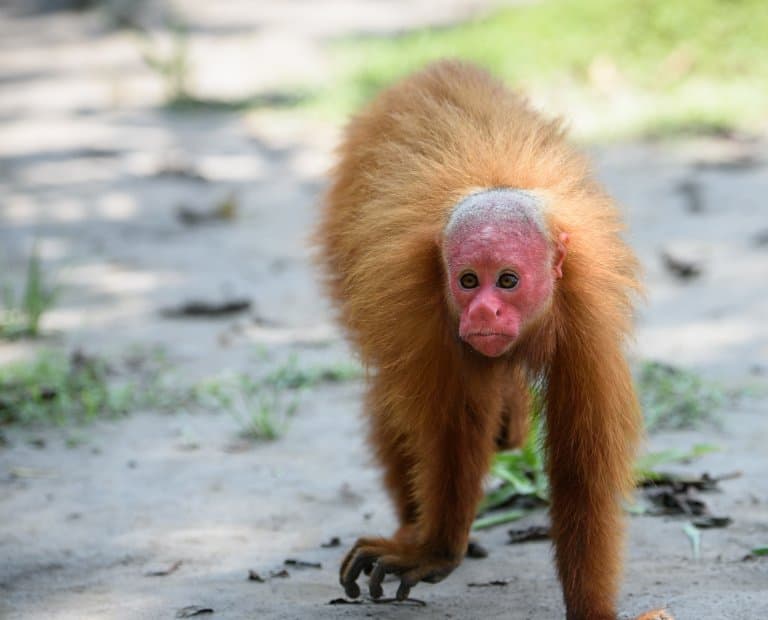
13. They are very important to the habitat in which they live
As they travel to find food, uakaris drop seeds in their faeces, which helps to reforest nearby areas. 4
Bald Uakari Fact-File Summary
Scientific Classification
| Kingdom: | Animalia |
| Phylum: | Chordata |
| Class: | Mammalia |
| Order: | Primates |
| Family: | Pitheciidae |
| Genus: | Cacajao |
| Species Name: |
Cacajao Calvus |
Fact Sources & References
- Gron KJ. (2008), “Primate Factsheets: Uakari (Cacajao) Taxonomy, Morphology, & Ecology“, Wisconsin National Primate Research Center.
- Maria DiCesare (2022),”Bald Uakari“, New England Primate Conservancy.
- Barry Berkovitz & Peter Shellis (2018), “Cacajao“, The Teeth of Mammalian Vertebrates.
- “Bald Uakari“, National Geographic.
